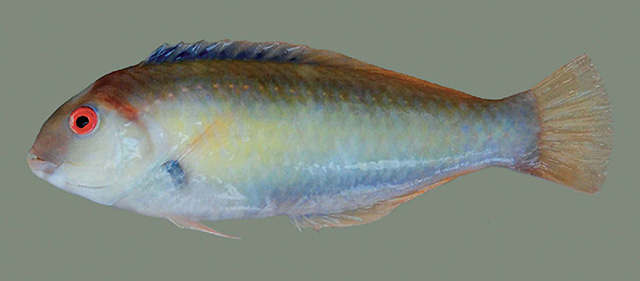|
Dorsal spines (total): 9-9; Dorsal soft rays (total): 12-12; Anal spines: 3-3; Anal soft rays: 12-12; Vertebrae: 24-24. This species is distinguished by the following characters: D IX,12, first spine flexible, remaining spines firm and sharp-tipped, the space between first two dorsal spines half space between second and third spines; A III,12; pectoral rays 12; head no scales; no median predorsal scales; scales on side of nape extending to above free dorsal end of preopercular margin; gill rakers 18-21; lateral-line scales 20 + 5; body depth 3.2 in SL; dorsal profile of snout evenly convex; suborbital depth short, less than eye diameter, 5.3-5.45 in head length (HL); caudal fin slightly rounded and short, 1.35-1.4 in HL; pelvic fins nearly or just reaching anus, 1.4 in HL. Preserved color of body in alcohol light yellowish brown; fins pale yellowish; a large black spot in axil of pectoral fins; a blackish spot on each membrane of spinous portion of dorsal fin, darker in male; color of body of male when fresh with a series of indistinct longitudinal bands: orangish brown below base of dorsal fin, blue in a zone along lateral line, the lateral-line pores white (progressively fainter posteriorly), light blue suffused with yellow in a broad zone along midside, and blue and white ventrally; snout and nape orangish gray with an oblique deep orange band behind eye; rest of head yellowish white; iris bright red; spinous dorsal fin blue with a deep blue spot ventrally on each membrane; remaining median and pelvic fins light orange; pectoral fins pale yellow with a bluish black spot in axil. Color of body of female purplish pink with 2 broad white longitudinal bands on lower side, narrowing posteriorly, and ending before caudal peduncle; ten close-set, oblique, white lines crossing abdomen from pectoral region of lower white band; a broad, oblique, dark purplish red zone from nape to upper operculum; a large black spot in axil of pectoral fins; fins pale yellowish to orangish (Ref. 93522). |
